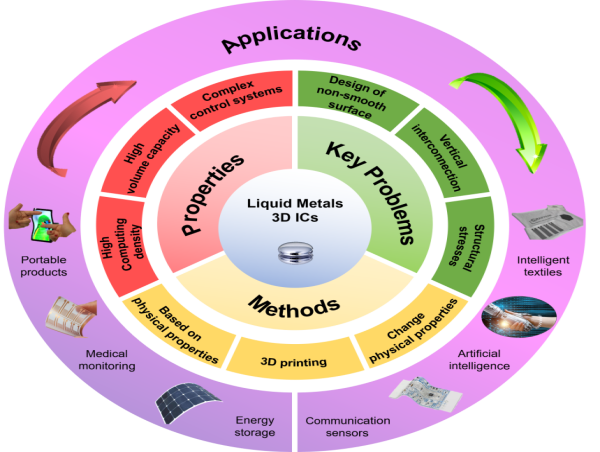GA, UNITED STATES, March 10, 2025 /EINPresswire.com/ -- This study explores liquid metal-based flexible three-dimensional integrated circuits (3D ICs), highlighting their exceptional conductivity, stretchability, and biocompatibility. By leveraging 3D printing and advanced fabrication methods, researchers achieve high-resolution, scalable circuits for wearable and biomedical applications. The work addresses key challenges such as oxidation, interconnect stability, and multilayer integration, paving the way for next-generation flexible electronics.
Flexible three-dimensional integrated circuits (3D ICs) enable high-density interconnects, miniaturization, and multifunctionality. Unlike rigid circuits, flexible 3D ICs can conform to various surfaces, making them ideal for wearables, biomedical devices, and soft robotics.
In a review published in the KeAi journal Wearable Electronics, a team of researchers explores the use of gallium-based liquid metals, which offer high conductivity, mechanical flexibility, and biocompatibility, as a core material for next-generation flexible 3D ICs.
“We noted that fabricating these circuits remains challenging particularly in achieving high-resolution patterning, ensuring interlayer stability, and addressing oxidation issues that impact performance and durability,” shares co-corresponding author Xiaodong Chen. “Hence, we focused on 3D printing-based fabrication methods that allow precise, scalable deposition of liquid metals.”
Conventional approaches, such as screen printing and microchannel molding, struggle with limited resolution and structural instability. In contrast, direct ink writing provides fine control over patterning, coaxial printing enhances circuit stability by encapsulating liquid metal, and hybrid printing combines multiple techniques to enable complex, multilayer interconnections.
“A key advantage of 3D printing is its ability to operate at room temperature, making it compatible with soft, stretchable, and bio-integrated substrates,” says the co-corresponding author Dianpeng Qi. “This feature allows flexible circuits to be printed directly onto polymers, hydrogels, and even textiles, paving the way for highly adaptable and functional electronic systems,”
Despite the benefits of 3D printing, liquid metal’s high surface tension and tendency to oxidize pose as major hurdles.
“To address this, researchers have explored ink modification strategies, such as doping with nanoparticles like carbon nanotubes and nickel, which enhance mechanical stability and adhesion while improving circuit durability,” says first author Ruiwen Tian. “Additionally, core-shell structures and oxide-layer engineering help regulate liquid metal flow, enabling more precise patterning. Beyond ink modifications, auxiliary printing techniques further refine fabrication.”
Freeze-assisted printing stabilizes liquid metal through controlled cooling, while hydrogel-supported printing suspends liquid metal in a gel matrix, allowing for freeform 3D structures. Liquid-phase printing, on the other hand, facilitates rapid solidification in a fluid medium, forming well-defined conductive pathways.
Beyond 3D printing, alternative fabrication strategies leverage liquid metal’s wetting properties, phase transformations, and magnetic control to construct flexible 3D ICs. Wettability-based circuit formation employs surface modifications like laser patterning and selective adhesion techniques to precisely guide liquid metal deposition. Phase transformation engineering enables pre-patterned conductive wires by solidifying gallium-indium alloys into controlled structures, which can later be embedded in soft substrates and reconfigured when heated.
“Additionally, embedding magnetic particles into liquid metal allows for remotely guided circuit formation, enabling reconfigurable electronics with tunable properties,” says Qi. “These approaches expand the possibilities for liquid metal circuits, offering new pathways to create adaptive, self-healing, and reprogrammable electronic systems.”
Notably, while significant progress has been made, key challenges remain in scalability, reproducibility, and long-term durability.
“Ensuring that flexible 3D ICs can maintain electrical integrity under repeated mechanical stress is crucial, especially for applications in wearable healthcare monitoring, bioelectronic implants, and robotic systems,” Qi adds. “Future research should focus on developing self-healing and reconfigurable circuits to extend device lifespan, optimizing biocompatibility for seamless integration with biological tissues, and leveraging AI-driven fabrication to enhance precision and scalability.”
By combining the unique properties of liquid metal with advanced manufacturing techniques, this review offers insights for the development of next-generation intelligent, high-performance flexible electronics for human-machine interactions.
Original Source URL
https://doi.org/10.1016/j.wees.2024.12.001
Funding information
This review is supported from the National Natural Science Foundation of China (Grant Nos. 52473255 and 2173237), the Fundamental Research Funds for the Central Universities (Grant Nos. HIT.OCEF.2022018 and HIT.NSRIF 202315) and the Natural Science Foundation of Heilongjiang Province, China (Grant Nos. LH2022E051 and LH2021B009). This work was also supported by the Interdisciplinary Research Foundation of HIT (Grant No. IR2021207) and the Open Project Program of Key Laboratory for Photonic and Electric Bandgap Materials Ministry of Education (Grant No. PEBM202107).
Lucy Wang
BioDesign Research
email us here
Legal Disclaimer:
EIN Presswire provides this news content "as is" without warranty of any kind. We do not accept any responsibility or liability for the accuracy, content, images, videos, licenses, completeness, legality, or reliability of the information contained in this article. If you have any complaints or copyright issues related to this article, kindly contact the author above.
![]()



